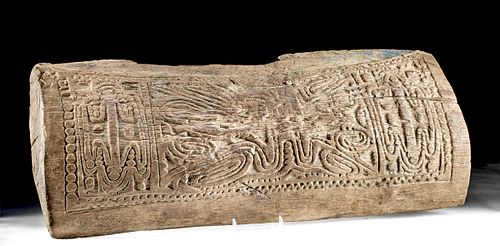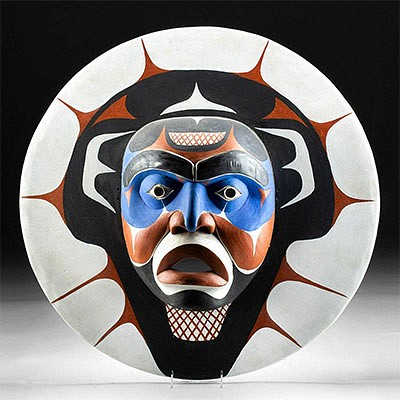18th C. Papua New Guinea Wood Drum Segment, C-14 Tested
Lot 114
About Seller
Artemis Fine Arts
686 S Taylor Ave, Ste 106
Louisville, CO 80027
United States
Selling antiquities, ancient and ethnographic art online since 1993, Artemis Gallery specializes in Classical Antiquities (Egyptian, Greek, Roman, Near Eastern), Asian, Pre-Columbian, African / Tribal / Oceanographic art. Our extensive inventory includes pottery, stone, metal, wood, glass and textil...Read more
Estimate:
$15,000 - $20,000
Absentee vs Live bid
Two ways to bid:
- Leave a max absentee bid and the platform will bid on your behalf up to your maximum bid during the live auction.
- Bid live during the auction and your bids will be submitted real-time to the auctioneer.
Bid Increments
| Price | Bid Increment |
|---|---|
| $0 | $25 |
| $300 | $50 |
| $1,000 | $100 |
| $2,000 | $250 |
| $5,000 | $500 |
| $10,000 | $1,000 |
| $20,000 | $2,500 |
| $50,000 | $5,000 |
| $100,000 | $10,000 |
| $200,000 | $20,000 |
About Auction
By Artemis Fine Arts
Mar 18, 2021
Set Reminder
2021-03-18 10:00:00
2021-03-18 10:00:00
America/New_York
Bidsquare
Bidsquare : Pre-Columbian | Tribal | Oceanic
https://www.bidsquare.com/auctions/artemis-gallery/pre-columbian-tribal-oceanic-6520
Featuring Pre-Columbian, Native American, African / Tribal, Oceanic, much more. All items have been legally acquired and are legal to sell. Convenient in-house shipping. Artemis Fine Arts info@artemisgallery.com
Featuring Pre-Columbian, Native American, African / Tribal, Oceanic, much more. All items have been legally acquired and are legal to sell. Convenient in-house shipping. Artemis Fine Arts info@artemisgallery.com
- Lot Description
Oceania, Papua New Guinea, East Sepik region, ca. 18th to 19th century CE. A large hand-carved wooden section from a garamut drum with intricate patterns on the exterior face. This section is formed from a singular piece of wood and is roughly rectangular with a slightly curved profile. When complete, the drum would have a slit down one side and a hollowed-out interior to form the resonance chamber. The center is extensively embellished with relief carvings shaped by incised curvilinear and geometric motifs. Some of the imagery is hard to discern, but these shapes may be abstract faces that represent ancestor spirits. This slit drum or garamut, is the most important instrument in the Sepik River area. Such drums are used in ceremonies, to issue warnings, and to call people to meetings. Traces of blue paint, which might be a natural blue ochre pigment, remain along one side, indicating this may have once been brightly painted to highlight the motifs Size: 34" L x 4" W x 14" H (86.4 cm x 10.2 cm x 35.6 cm)
See a Garumut drum at the Minneapolis Institute of Art (object number 93.12). The curatorial description includes this wonderful contextual passage about the ancestral figures depicted on the drum as well as the sound made by the drum capturing its voice: "These figures represent important ancestors and demonstrate clan affiliation. The people of the Sepik area understand the drum's sound as its 'voice.' This voice can carry long distances to announce meetings, call individuals, issue warnings, and even contact neighboring villages. Communication occurs through a complex series of rhythms and tones beat out with a wooden stick by an initiated man. More than just an instrument, this drum is central to the lives the entire community."
This piece has been tested using radiocarbon dating (C-14) analysis and has been found to be ancient and of the period stated. A full report will accompany purchase.
Provenance: private Hawaii, USA collection; ex-Dr. Gallagher collection, Sydney, Australia 1960 to 2000
All items legal to buy/sell under U.S. Statute covering cultural patrimony Code 2600, CHAPTER 14, and are guaranteed to be as described or your money back.
A Certificate of Authenticity will accompany all winning bids.
We ship worldwide and handle all shipping in-house for your convenience.
#161522Fragment of a larger piece. Pressure fissures and cracks as shown. Losses and chips as shown. Surface abrasions interfere with parts of the decorative program. Traces of blue pigments! Modern wire on verso for mounting.Condition
- Shipping Info
-
All shipping is handled in-house for your convenience. Your invoice from Artemis Gallery will include shipping calculation instructions. If in doubt, please inquire BEFORE bidding for estimated shipping costs for individual items.
-
- Buyer's Premium



 EUR
EUR CAD
CAD AUD
AUD GBP
GBP MXN
MXN HKD
HKD CNY
CNY MYR
MYR SEK
SEK SGD
SGD CHF
CHF THB
THB














